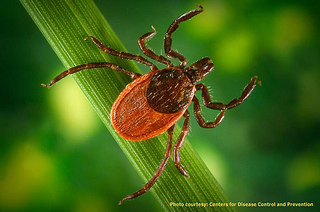Blacklegged Deer Tick
Taxonomy
Arthropoda » Chelicerata » Arachnida » Acari » Ixodida » Ixodidae » Ixodes » Blacklegged Deer Tick
Physical Description
The Blacklegged Deer Tick is tear drop shaped and relatively small. Its dorsal shield is black while the body behind it is reddish-brown (as an adult), unless the tick is engorged with blood which fades the color to a grey or even a grey-ish blue. When engorged, this means it recently had a “meal” you might say. Also, as you may have already put together because of the name, they have black legs. Adults are generally the length of a sesame seed, size being 1/8th inch, while immature ticks are closer to a poppy seed size.

Location & Habitat
They are very abundant in the northeast region of the United States but you could also say they are generally located in the northern U.S. They are found in woods, forests, and very grassy areas. Ticks don’t fly or jump but merely “quest” for a host. They do this by holding onto the grass or shrub, with its back legs, and keeping their upper legs outstretched hoping to grab onto its next host passing by.
Prey & Predators
This pest typically preys on any host that it can. Starting as small as birds, amphibians, small animals such as squirrels and mice and onto larger animals such as humans, deer, bear, and other wild animals. They also don’t mind clinging to a family pet. Rule of thumb, if it has blood, it is probably susceptible to being a tick’s host. Their predators have not been reported mostly because it's predators aren’t even maintaining the over-growing population of these pesky blood-suckers.
Are Blacklegged Deer Ticks Harmful to Humans?
Ticks are very harmful to humans and also many other wildlife. They are formally known for carrying Lyme disease. It carries many more diseases and sicknesses than just Lyme disease. All deer ticks, at any age, have the potential to infect a human with Lyme disease. Most commonly though, the nymph stage of this tick is successful in doing so because they are much smaller and are not found or noticed for several days. Typically, the tick cannot transmit the disease for 36-48 hours after attaching to its host, this is why adult ticks are less likely to do so.
Most people will notice an adult tick and especially an engorged adult tick within the day of attaching. Still, prevention is key when it comes to ticks. Light colored, long sleeves and bottoms are the best types of clothing to wear when out and about in the woods or even a high-grass yard or field. Your chances of seeing them crawling on you, with this much on, are much more likely and you will slow them down from finding a good place for them to bite and plant themselves. Other prevention tips would be to walk in the middle trails or paths to prevent rubbing up against any shrubbery. Last but certainly not least, a insect repellant targeted specifically for ticks is necessary for long periods of time out in the previously mentioned habitats.
Reproduction & Life Cycle
Deer ticks have a two year life cycle. They are first eggs, then larvae, nymphs, and then adults. The larvae will feed on small mammals such as birds and mice. Soon after, they molt into the nymph stage. The nymphs become dormant during the fall and winter seasons. When late spring and summer arrive, they feed on larger animals such as dogs, deer, and other wild animals. When fall arrives again, the nymphs molt into the adult stage. The females then find a deer or other larger animal to feed on throughout the colder months, mate, lay their eggs, and then die. The male does not eat any blood meals during its adult transformation. They only attach to a host to spot and mate with a female.
Other Names
Ixodes scapularis

